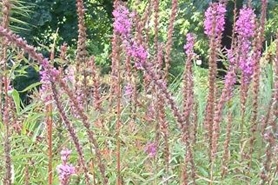Wanded Loosestrife
(Lythrum virgatum)
Similar to the more commonly known purple loosestrife (Lythrum salicaria), wanded loosestrife is a European wetland plant introduced to North America and widely sold as an ornamental. Plants grow 3-4 feet tall with showy pink to purple flowers on four-angled stems. It can spread through seeds when cross-pollinated with other Lythrum species or through rooting stem fragments.
Other names for this plant include:
- Common names: European wand loosestrife
Classification in Wisconsin: Prohibited
- Ecological Threat
-
- Adapts to a range of environments with moist soils and shallow waters where it competes with native wetland plants.
- Through seed or vegetative spread, it can form dense monocultures of little value to wildlife.
- It has been widely planted as an ornamental where it escapes to nearby waterways. It is sometimes sold in nurseries as a sterile variety; however, it can still produce viable seeds when cross-pollinating with wild varieties.
- Identification
-
Leaves grow lance-shaped 1 to 5 inches long and up to 1.5 inches wide. They are hairless and grow oppositely arranged (sometimes alternately) on the stems.
Flowers: Flowers are showy, purple to pink in color and grow in spikes 5 to 10 inches long at stem ends (terminal). Each flower spike comprises many small flowers with 5-6 petals.
Fruits & seeds: Seed capsules are cylindrical and up to 5 mm long. They open when mature in late July-August.
Roots: A sizeable woody taproot with fibrous rhizomes; rhizomes form dense mats.
Stems: Stems are upright and 4-angled, growing up to 3 or 4 feet tall.
Similar species: Wanded loosestrife is identical to purple loosestrife but is smaller, hairless and smooth with narrower leaves, and flowers are mostly paired or clustered in leafy, open flower clusters. It can be distinguished from the similar native fireweed (Chamerion angustifolium) by its narrower, more slender flower spikes and four-edged stems. Native wing-angled loosestrife (Lythrum alatum) is found in moist prairies and wet meadows; it has winged, square stems and solitary flowers in the leaf axils. Lower leaves are paired while the upper leaves are alternate.
- Distribution
-
Currently, there have been no reports of wanded loosestrife in Wisconsin. Have you seen it? Please send us a report.
- Control
-
Mechanical: Small plants and seedlings can be dug out. Larger plants can be dug out, making sure to remove root fragments. Remove all plant parts and either burn, landfill or bury them deep in the ground. Mowing is not recommended due to plant parts starting new populations and seed dispersal.
Chemical: If near water, a permit may be required. Foliar treatments of aquatic formulations of imazapyr or glyphosate may work.
Biological: Galerucella beetles have been successful in many parts of the state in controlling purple loosestrife populations and are likely to affect wanded loosestrife. Want to get involved with biocontrol? Please find out more on our purple loosestrife biocontrol page.
- Resources
- Sources for content:
- Invasive Plants of Asian Origin Established in the US and Their Natural Enemies; 2004; USDA Forest Service; p. 106-107.
- Washington State Noxious Weed Control Board Fact Page on Wanded Loosestrife [exit DNR]



